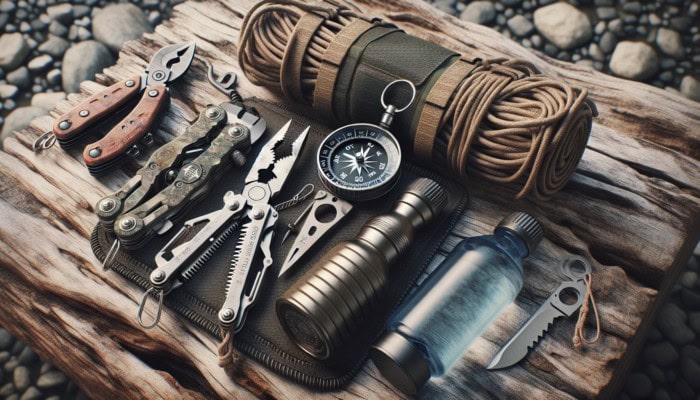Mastering Wilderness Survival: Essential Skills and Techniques for Thriving Alone
Surviving alone in the Wilderness involves more than mere determination; it necessitates a comprehensive set of essential skills and techniques that can drastically influence your chances of survival. Embarking on this adventure in nature requires physical endurance, mental sharpness, and a profound understanding of the environment surrounding you. Acquiring and mastering key survival skills is crucial for anyone who finds themselves cut off from the conveniences of modern life.
Fire Crafting: Mastering Diverse Techniques for Igniting Fire in Varied Weather

The capability to start a fire is among the most vital skills essential for surviving alone in the wilderness. Fire serves multiple purposes, including providing warmth, offering light, enabling food preparation, and purifying drinking water. Different weather conditions can present unique challenges, but with diligent practice in various fire-starting methods, you can enhance your proficiency in creating a fire, regardless of the situation.
Traditional methods like matches or lighters work well in arid climates, but in wet or damp conditions, alternative fire-starting techniques may be required. For instance, flint and steel can create sparks even in adverse weather, while the bow drill technique allows you to generate an ember through friction. Although mastering this ancient method demands practice, the rewards can be substantial.
Moreover, it is imperative to understand the suitable materials for tinder, kindling, and fuel. Dry leaves, pine needles, and bark can effectively function as tinder, while small twigs serve as kindling and larger branches act as fuel. Always survey your surroundings for natural resources to facilitate a swift fire setup.
Constructing Shelters: Proven Techniques for Building Protective Structures from Natural Materials
Building a shelter is another foundational element of surviving alone in the wilderness. Exposure to harsh environmental conditions can lead to serious health risks like hypothermia or heat exhaustion, making a well-crafted shelter essential for your survival. The type of shelter you construct will depend largely on your mainlyment and the available resources.
Using fallen branches and leaves can offer excellent insulation and protection in forested regions. A basic lean-to shelter can be constructed by propping a sturdy branch against a tree and covering it with foliage to enhance camouflage and warmth. Alternatively, using caves or natural overhangs in rocky areas can provide immediate refuge; however, assessing these locations for potential hazards, such as falling rocks or local wildlife, is crucial.
As you build your shelter, consider the wind direction and select a site that provides natural protection. Insulating the floor with leaves, pine boughs, or grass can create a barrier against the cold ground, significantly improving your comfort and warmth.
Water Acquisition: Techniques for Identifying and Purifying Water Sources in Nature
Water is vital for survival, and identifying a clean source is crucial when surviving alone in the wilderness. Natural sources such as streams, rivers, and lakes may be present in various environments, but knowing how to identify safe water and purify it for drinking is essential.
Look for flowing water, as stagnant pools can often harbor harmful bacteria. Clear water from streams is typically safer to drink than murky water. Boiling water is the most effective method for purification; bringing it to a rolling boil for at least one minute will eliminate most pathogens. If you cannot start a fire, consider using water purification tablets or filtration systems as alternative options.
Additionally, you can collect rainwater or dew using containers or cloths to supplement your water supply, especially in regions with limited other sources. Staying hydrated is vital; thus, understanding how to source and purify water can significantly impact the chances of survival.
Essential Tools and Gear for Wilderness Survival

While skills are undeniably critical, having the right tools and equipment can significantly improve your chances of surviving alone in the wilderness. A thoughtfully curated selection of gear can equip you with the necessary resources to address your various challenges.
Multi-Tool: The Indispensable Versatile Tool for Diverse Tasks
A multi-tool is an invaluable companion when surviving alone in the wilderness. Its compact design typically encompasses a knife, pliers, screwdrivers, and various other tools, making it exceedingly versatile. In survival situations, you may need to tackle numerous tasks ranging from food preparation to shelter construction or gear repair.
The adaptability of a multi-tool enables you to manage these tasks effectively without the encumbrance of a bulky toolkit. For instance, the knife can be employed for food prep or skinning small game, while the pliers can assist in gathering firewood or fixing equipment.
When choosing a multi-tool, ensure it is robust, lightweight, and includes tools that align with your specific survival requirements. Quality is essential; investing in a reliable multi-tool can offer peace of mind as you navigate the demands of the wilderness.
Survival Knife: Selecting the Optimal Knife for Cutting, Carving, and Self-Defense
A survival knife is arguably the most crucial equipment for anyone serious about surviving alone in the wilderness. The right knife can fulfill multiple functions, including cutting, carving, and even self-defense against potential threats.
Consider factors like blade material, size, and weight when choosing a survival knife. Generally, a fixed-blade knife is more durable than a folding knife, making it a better option for survival scenarios. Look for a knife with a full tang, as this design offers increased strength and resilience.
The blade should ideally measure between 4 to 6 inches in length, promoting precision while remaining manageable. A serrated edge can be advantageous, allowing you to easily cut through more rigid materials like rope or small branches. Additionally, ensure that the knife features an ergonomic grip, enabling you to use it effectively for prolonged periods without discomfort.
Emergency Blanket: The Life-Saving Benefits of an Emergency Blanket in Extreme Conditions

An emergency blanket, often called a space blanket, is a lightweight yet highly effective tool for surviving alone in the wilderness. These blankets are designed to reflect body heat, providing warmth in cold conditions while protecting against the elements.
When hypothermia is a concern, an emergency blanket can be a lifesaver. Simply wrapping yourself in one can help retain heat and prevent excessive body temperature loss. Additionally, emergency blankets are waterproof, creating a barrier against rain and wind, greatly enhancing survival in adverse weather.
Compact and easy to carry, emergency blankets are an excellent addition to any survival kit. Their reflective surface can be utilized for signaling in emergencies. By positioning them to catch sunlight or other light sources, you can attract the attention of potential rescuers.
Mastering Navigation and Orientation in the Wilderness
Navigating through the wilderness can be daunting without the guidance of modern technology. However, with the appropriate skills, you can confidently find your way, even while surviving alone in the wilderness. Mastering navigation techniques is essential for ensuring safety and maintaining directional awareness.
Utilizing the Sun and Stars: Time-Tested Methods for Navigation Without a Compass
For those who find themselves lost, knowing how to use the sun and stars can provide reliable navigation. During daylight hours, the sun rises in the east and sets in the west, acting as a natural compass. Observing the sun’s trajectory lets you ascertain your orientation and navigate accordingly.
At night, the stars become your guiding lights. The North Star, located at the end of the Little Dipper, remains fixed in the northern sky and can help you orient yourself while navigating after sunset. You can find true north by pinpointing the North Star, which is invaluable for charting your course.
Additionally, learning to recognize specific constellations can further aid your navigation efforts. For example, the Big Dipper can direct you to the North Star, a reliable reference point in the night sky. Familiarizing yourself with these celestial markers can enhance your ability to navigate confidently when natural landmarks are scarce.
Interpreting Topographic Maps: The Importance of Understanding Terrain for Navigation
A critical skill for surviving alone in the wilderness is the ability to read and interpret topographic maps. These maps deliver detailed information about the terrain, including elevation changes, water sources, and significant landmarks. Grasping how to read these maps can be essential for effective navigation.
Become acquainted with the symbols and lines displayed on a topographic map. Contour lines indicate elevation; tightly spaced lines signify steep inclines, while widely spaced lines indicate gentler slopes. Understanding these features can help you plan your route effectively, steer clear of hazardous areas, and pinpoint potential resources.
Moreover, practicing orienting your map with a compass is advantageous to ensure you accurately follow your desired path. Regularly referencing your surroundings against the map can keep you on track and help prevent disorientation.
Mastering Compass Use: Fundamental and Advanced Techniques for Effective Navigation
A compass is a crucial navigation instrument, mainly when alone in the wilderness. However, knowing how to utilize it effectively is vital. Begin by understanding the compass’s components, including the needle, baseplate, and degree markings.
To use a compass, hold it flat in your hand and rotate your body until the needle aligns with the orienting arrow. This alignment will provide you with a clear direction to follow. From this point, you can identify your destination by aligning the compass with a visible landmark.
Advanced techniques include triangulation, which involves taking bearings from two or more visible landmarks to pinpoint your location on a map. This method proves particularly useful in dense forests or unfamiliar terrain where visibility may be limited. Mastering compass usage can significantly enhance your navigation skills and overall safety in the wilderness.
Foraging and Food Sourcing for Wilderness Survival
Sourcing food is one of the most pressing concerns when surviving alone in the wilderness. Foraging and hunting can provide the necessary sustenance to keep you alive, but knowledge and preparation are essential for success.
Identifying Edible Plants: Recognizing Safe and Nutritious Flora in Various Environments
Foraging for edible plants necessitates a discerning eye and a thorough understanding of your surroundings. Countless plants can offer essential nutrients, but misidentification can lead to illness or worse outcomes. Learning to identify safe, nutritious plants is critical for your survival.
Begin by familiarizing yourself with common edible plants in your area. Wild greens, berries, nuts, and roots can be discovered in forests, fields, and rivers. Resources like field guides or mobile applications can aid identification, but consider learning from experienced foragers for practical insights.
Employ the “rule of three” when trying new plants: Consume a small quantity, wait 24 hours, and observe your body’s response before consuming more. Additionally, avoid plants with white or yellow berries, as many are toxic. Knowledge and caution are your best allies when foraging in the wild.
Ethical Hunting and Trapping: Effective Methods for Sourcing Animal Protein
In a survival scenario, hunting and trapping can provide viable options for obtaining animal protein. However, ethical considerations must guide your actions, ensuring you practice responsible hunting.
Learning to identify animal tracks and signs can help you locate potential prey. Setting traps, such as snares or deadfalls, can yield results without a weapon. Familiarize yourself with local laws regarding hunting and trapping and ethical practices to prevent over-harvesting.
When hunting, remember the importance of stealth and patience. Animals are often alert to their surroundings, so approaching quietly and camouflaging yourself can heighten your chances of success. Remember to utilize every part of the animal, ensuring minimal waste and demonstrating respect for nature.
Fishing Techniques: Diverse Methods for Catching Fish in Freshwater and Saltwater
Fishing is another excellent approach for securing food while surviving alone in the wilderness. Various techniques can be employed to catch fish effectively in freshwater or saltwater.
Traditional rod-and-reel fishing can be highly productive in freshwater, but when resources are constrained, creating simple fishing traps or using improvised spears can yield results. Baiting hooks with natural materials like worms or insects can attract fish.
Understanding tidal patterns and fish behavior can enhance your success rate in saltwater. Surfcasting from the beach or boat can grant access to larger species. Be aware of local fishing regulations and sustainability practices to protect marine life.
Health and First Aid Essentials for Wilderness Survival
When surviving alone in the wilderness, prioritizing health and safety is crucial. Understanding basic first aid and how to address common injuries can mean the difference between a minor setback and a life-threatening situation.
Fundamental First Aid Skills: Treating Common Injuries and Illnesses
Basic first-aid skills are vital for anyone venturing into the wilderness. Knowing how to treat injuries such as cuts, scrapes, fractures, or burns can help you manage emergencies effectively. Understanding how to clean wounds to prevent infection is essential.
Always carry a compact first aid kit with antiseptic wipes, bandages, gauze, and other necessary items. In addition to addressing physical injuries, recognizing signs of hypothermia or heat exhaustion is critical for maintaining health in extreme conditions.
Knowing how to improvise with available materials can be invaluable without professional medical assistance. For example, using clean cloth to dress a wound or creating a splint from sturdy branches can aid in recovery and protect against further injury.
Utilizing Natural Remedies: Employing Plants and Herbs for Medicinal Purposes
Nature is often a source of remedies for common ailments, and being familiar with medicinal plants can greatly assist significantly in the wilderness. Numerous plants possess healing properties that can be utilized for treating injuries or illnesses.
For instance, calendula can be used for its anti-inflammatory effects, while willow bark is a natural pain reliever. Learning to identify these plants and understanding their uses will enhance your capacity to manage health challenges in the wild.
However, caution is paramount. Always ensure accurate identification before using any plant for medicinal purposes, as misidentification can lead to adverse effects. Building a knowledge base of local flora and their applications is a worthwhile investment in your survival skills.
Mental Well-Being: Strategies for Maintaining Psychological Health During Isolation
Mental health is as critical as physical well-being when surviving alone in the wilderness. Prolonged isolation can breed feelings of loneliness, anxiety, or despair, making it essential to implement strategies that support mental resilience.
Establishing a daily routine can provide structure and a sense of purpose to your day. Setting small, achievable goals—gathering firewood or preparing a meal—can help maintain focus and motivation.
Incorporating mindfulness techniques, such as meditation or deep breathing exercises, can alleviate stress and anxiety. Taking time to appreciate the beauty of your surroundings can foster a positive mindset, allowing you to remain grounded even in challenging situations.
Weather and Environmental Challenges in Wilderness Survival
Weather conditions can profoundly impact your survival experience; thus, understanding how to cope with various environmental challenges is essential. Knowledge and preparation can enhance your resilience when facing extreme temperatures, storms, or rugged terrain.
Enduring Extreme Temperatures: Strategies for Surviving in Hot and Cold Climates
Extreme temperatures present unique challenges when surviving alone in the wilderness. In cold environments, wearing layered clothing is vital for insulation. Ensure your outer layer is waterproof to protect against the elements. Constructing a warm shelter and insulating materials like leaves or moss can help maintain warmth during frigid nights.
Staying hydrated is paramount in hot climates. Seek shade during the hottest parts of the day and wear lightweight, loose-fitting clothing to minimize the risk of overheating. Understanding how to ration water and locate natural sources can prevent dehydration.
Both hot and cold environments require adaptability and knowledge of effectively managing body temperature. Recognizing the symptoms of heat exhaustion or hypothermia can be life-saving, enabling you to take proactive measures before conditions worsen.
Preparing for Storms: Strategies for Surviving Severe Weather Conditions
Storms can arise unexpectedly, especially in remote areas, making preparation essential. Knowing how to find shelter and protect yourself from severe weather is critical when surviving alone in the wilderness.
Before a storm approaches, evaluate your surroundings for potential hazards, such as falling branches or flood-prone areas. Seek natural shelter, such as caves or rock overhangs, and avoid areas susceptible to flash floods.
Once you are safe, stay low to the ground and protect your head and neck. Utilizing your emergency blanket can provide warmth and shelter from the elements. After the storm has passed, carefully assess your surroundings, as the landscape may have changed, introducing new dangers.
Navigating Varied Terrain: Strategies for Moving Through Different Landscapes
Different terrains present unique challenges that require adaptation to survive alone in the wilderness. Whether traversing dense forests, rocky mountains, or marshy wetlands, understanding the landscape can significantly improve one’s ability to navigate safely and efficiently.
Maintaining visibility and avoiding dense undergrowth in forested areas can help prevent injury and disorientation. Rocky terrain necessitates careful foot placement and awareness of potential hazards, such as loose stones or steep drops.
Awareness of the dangers posed by muddy ground or concealed obstacles is crucial in wetlands. Using walking sticks can enhance stability, while scouting ahead helps identify safe paths. Adapting your strategies to the terrain can greatly enhance significantlyances of success.
Long-Term Survival Strategies for Extended Wilderness Living
Implementing long-term strategies becomes essential for those facing a prolonged survival scenario. Embracing sustainable practices can ensure survival while preserving the environment around you.
Sustainable Living: Techniques for Coexisting with Nature While Living Off the Land
Sustainable living is crucial when surviving alone in the wilderness for extended periods. Learning to thrive off the land without depleting resources involves understanding the balance of nature and practicing responsible foraging and hunting.
Rotating foraging areas and avoiding over-harvesting are vital for ensuring that local ecosystems remain healthy. When hunting, consider taking only what you require and utilizing every part of the animal to minimize waste.
Additionally, incorporating permaculture techniques, such as planting edible plants or creating small gardens, can provide a renewable food source. Understanding the local ecosystem and its cycles will help you coexist sustainably with nature.
Effective Signaling for Help: Methods for Attracting Rescue in Remote Areas
If you find yourself in a situation where rescue is necessary, knowing how to signal for help is crucial. Various methods can enhance your chances of being located while surviving alone in the wilderness.
Creating visible signals, such as large SOS signs made from rocks or branches, can attract the attention of aerial searchers. Smoke signals can also be effective; creating a fire with green foliage generates thick smoke.
Moreover, utilizing reflective materials or mirrors can help catch sunlight, signaling to potential rescuers. Always be aware of your surroundings and leverage natural features to improve visibility when requesting assistance.
Maintaining Morale: Psychological Techniques for Staying Motivated and Focused
Mental resilience is key to surviving alone in the wilderness. Keeping morale high can be challenging, especially during prolonged periods of isolation. Developing psychological techniques to stay motivated and focused is essential for long-term survival.
A daily routine can foster structure and purpose, helping you remain engaged with your environment. Setting achievable goals, such as collecting firewood or foraging for food, can create a sense of accomplishment.
Practicing mindfulness and gratitude can also enhance your mental state. Appreciating the natural beauty around you or reflecting on positive experiences can shift your mindset and cultivate hope, even in difficult circumstances.
Learning from Case Studies and Real-Life Survival Stories
Gaining insights from others’ experiences can provide invaluable lessons in surviving alone in the wilderness. Case studies and real-life stories offer important takeaways that can inform your survival strategies and decisions.
Inspirational Survival Stories: Gleaning Insights from Notable Survivors
Numerous famous survival stories underscore the importance of resilience and resourcefulness in extreme situations. From Aron Ralston, who famously amputated his arm to escape a boulder, to the harrowing account of the Uruguayan rugby team who survived a plane crash in the Andes, these narratives impart lessons in determination and ingenuity.
Analyzing their experiences allows us to reflect on the choices that led to their survival and the skills they relied upon. Often, these accounts emphasize the significance of mental fortitude and adaptability in rapidly changing circumstances.
Modern Survivalists: Learning from Individuals Living Off the Grid Today
Contemporary survivalists possess a wealth of knowledge for those interested in surviving alone in the wilderness. Many individuals and families opt to live off the grid, relying on their skills and expertise to thrive in remote settings.
By sharing their experiences through blogs, videos, and workshops, these survivalists offer practical insights into sustainable living, foraging, and self-sufficiency. Learning from their successes and challenges can motivate others to develop their survival skills and strategies.
Survival Competitions: Valuable Lessons from Participants in Reality Shows
Survival reality shows have gained significant popularity. They showcase the challenges and skills required for surviving alone in the wilderness. Participants confront extreme conditions that test their physical and mental limits.
These competitions often highlight the importance of teamwork, adaptability, and resourcefulness. By analyzing the strategies employed by contestants, viewers can glean valuable insights into effective survival techniques and the mindset required to thrive in the wilderness.
Preparing for the Unexpected: Essential Strategies for Wilderness Survival
Preparation is crucial for surviving alone in the wilderness. Anticipating potential challenges and equipping yourself with the right resources can significantly enhance your chances of success.
Emergency Kits: Essential Items to Include in Your Survival Kit for Various Scenarios
Creating a well-rounded emergency kit tailored to your needs is imperative for survival. When surviving alone in the wilderness, consider including a first aid kit, fire-starting supplies, a multi-tool, and water purification tablets.
Additionally, packing non-perishable food items, a flashlight, and a whistle can bolster your preparedness. Customizing your kit based on the environment you’ll be in is crucial; for example, if venturing into a colder climate, include thermal blankets and hand warmers.
Regularly checking and updating your kit ensures you remain prepared for unforeseen circumstances.
Training and Courses: Recommended Survival Training Programs and Workshops
Survival training can significantly enhance your readiness to survive alone in the wilderness. Numerous courses cover wilderness first aid, fire-making techniques, and foraging skills.
These courses often provide hands-on experience and valuable insights from knowledgeable instructors. Participating in survival workshops or outdoor education programs can equip you with practical skills and boost confidence in your abilities.
Moreover, joining local survival groups or online forums can connect you with like-minded individuals, creating opportunities to share knowledge and experiences.
Mental Preparation: Cultivating the Right Mindset for Wilderness Survival
Mental preparation is as critical as physical skills when surviving alone in the wilderness. Developing the right mindset enables you to confront challenges with resilience and confidence.
Mindfulness techniques, such as meditation or journaling, can enhance self-awareness and emotional regulation. Setting realistic expectations and preparing for potential setbacks can foster a proactive mindset, allowing you to navigate difficulties more effectively.
Additionally, visualizing success and maintaining a positive outlook can strengthen your resolve and help you focus on survival objectives. Mental preparation is a vital component of your overall survival strategy.
FAQs
What essentials should I pack for a survival trip?
Pack a multi-tool, survival knife, emergency blanket, first aid kit, fire-starting supplies, non-perishable food, water purification tablets, and navigation tools.
How can I find clean water in the wilderness?
Seek flowing streams or rivers. Boil water for purification, or utilize water purification tablets or filters if available.
What are some common edible plants I should know?
Common edible plants include dandelion greens, clover, wild garlic, and berries like blackberries and blueberries. However, proper identification is always required before consumption.
What first aid skills are crucial for survival?
Essential first-aid skills involve treating cuts, burns, and sprains, recognizing signs of hypothermia or heat exhaustion, and cleaning wounds to avert infection.
How can I signal for help while in the wilderness?
To attract the attention of rescuers, create large SOS signs using rocks, smoke signals, or reflective materials.
What should I do in extreme weather conditions?
In cold weather, layer clothing and seek shelter; in hot weather, maintain hydration and find shade. Always be vigilant for signs of heat exhaustion or hypothermia.
How do I build a shelter in the wild?
Use natural materials such as branches and leaves to create a lean-to or debris hut. Ensure it’s insulated and offers protection from wind and rain.
What ethical hunting methods should I follow?
Ethical hunting practices include using traps, snares, or bows, taking only what you need, and adhering to local wildlife regulations.
How can I support my mental health during isolation?
To maintain mental well-being, establish a routine, set achievable goals, practice mindfulness, and appreciate your surroundings.
What survival training courses should I consider taking?
Consider courses on wilderness survival, first aid, foraging, and navigation. Look for local workshops or online programs to gain hands-on experience.
Explore our world on X!
Survival Compass Guide: Essential Tips for Navigation
Mastering Compass Navigation: Essential Knowledge and Techniques What is a Compass and Its Importance? Survival Compass Guide: A compass is an indispensable navigational tool that enables individuals to ascertain direction in relation to the Earth’s magnetic poles. This device typically features a magnetised needle that consistently points towards magnetic north, facilitating orientation in unfamiliar terrains. […]
SHTF Hunting Skills: Essential Techniques for Survival
Mastering the Essentials of SHTF Hunting Gaining Insight into Prey Behaviour for Success SHTF Hunting Skills: Understanding the habits and patterns of various animals is fundamental to increasing your chances of a successful hunt. This knowledge is not merely beneficial but essential for survival in any environment, particularly during an SHTF scenario where food sources […]
Wilderness Weather Prediction: Essential Techniques
Comprehending the Dynamics of Wilderness Weather Patterns Key Factors That Influence Weather Variability in Wilderness Areas Wilderness Weather Prediction: The weather in wilderness regions is a multifaceted interaction among numerous elements that can fluctuate dramatically depending on the surrounding environment. One of the most significant factors is altitude; as one ascends, temperatures generally decrease, which […]
Shtf Fire-Starting: Essential Techniques and Tools
Mastering the Fundamental Concepts of SHTF Fire-Starting Comprehending the Essential Fire Triangle Shtf Fire-Starting: The fire triangle is a fundamental concept that anyone serious about SHTF fire-starting must understand. This triangle comprises three vital elements: heat, fuel, and oxygen. Mastering these components is essential for successful fire-starting in any scenario. Without heat, you cannot ignite […]








The emphasis on firecrafting as a fundamental wilderness survival skill resonates deeply with me, particularly given its essential role not only in survival but also in connecting us with our primal roots. Just a few months ago, I embarked on a solo camping trip where I realized how dramatically my comfort levels shifted with the presence of fire. Being able to create and maintain a fire transformed what could have been a daunting night into a peaceful one, where I could cook a warm meal, ward off the chill, and experience that understated yet powerful calm that comes from watching flames dance in the dark.
It’s interesting how something as elemental as fire can shift our entire experience in the wilderness. Your solo camping trip seems to have provided a profound connection not just to the outdoors, but also to that sense of comfort and safety that fire offers. When you’re out there, it’s almost like fire becomes a companion—bringing warmth, light, and a sense of control amidst the unpredictability of nature.
You’ve touched on a crucial aspect of wilderness survival—fire crafting really is a game changer. I remember my first solo camping trip, where I underestimated the time it would take to get a fire going in damp conditions. It was a humbling experience that taught me not just the techniques but the importance of patience and preparation.
Your exploration of fire crafting highlights one of the most fundamental survival skills that often gets overlooked in urban environments. I remember my first attempts at starting a fire in less-than-ideal conditions; it was a humbling experience that taught me the importance of preparation. In addition to the techniques you mention, I’ve found that understanding materials native to the area, like fatwood or birch bark, can significantly improve success rates.
I really appreciate how you’ve highlighted the multifaceted nature of fire crafting in wilderness survival. It’s fascinating to think about how something as simple as a flame can transform survival situations! I remember a camping trip where I learned a few different fire-starting techniques, from using flint and steel to the good old-fashioned hand drill. Each method had its own quirks, particularly when it came to responding to different weather conditions.